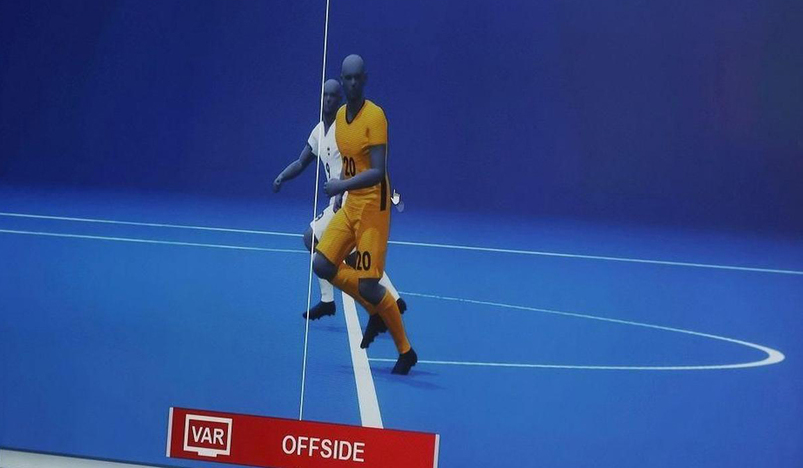
Semi-automated Offside Technology
FIFA has announced that semi-automated offside technology will be used at the FIFA World Cup 2022 in Qatar starting on 21 November, offering a support tool for the video match officials and the on-field officials to help them make faster, more accurate and more reproducible offside decisions on the biggest stage of all.
FIFA announced in a statement that this technology would be used in all 64 matches in Qatar.
FIFA pointed out that following the successful use of VAR technology at the 2018 FIFA World Cup in Russia, FIFA President Gianni Infantino declared in The Vision 2020-23 that FIFA would strive to harness the full potential of technology in football and further enhance VAR and ever since FIFA has indeed continued to be at the cutting edge of technology in the game.
The new technology was called Semi-automated because the final decision on whether or not to be offside ultimately rests with the VAR, unlike goal-line technology that categorically determines that the ball has crossed the offside line.
The statement said that FIFA has spent the last few years further improving the VAR system, including the use of semi-automated offside technology to accurately identify offside cases by working with various partners especially the Working Group for Innovation Excellence and technology providers.
The new technology uses 12 dedicated tracking cameras mounted underneath the roof of the stadium to track the ball and up to 29 data points of each individual player, 50 times per second, calculating their exact position on the pitch. The 29 collected data points include all limbs and extremities that are relevant for making offside calls.
Al Rihla, adidas official match ball for Qatar 2022 , will provide a further vital element for the detection of tight offside incidents as an inertial measurement unit (IMU) sensor will be placed inside the ball. This sensor, positioned in the center of the ball, sends ball data to the video operation room 500 times per second, allowing a very precise detection of the kick point.
The FIFA pointed out that by combining the limb- and ball-tracking data and applying artificial intelligence, the new technology provides an automated offside alert to he video match officials inside the video operation room whenever the ball is received by an attacker who was in an offside position at the moment the ball was played by a team-mate. In a few seconds it will be up to VAR officials to manually check the moment of the pass as well as the offside line, before informing the main referee who will make the final decision.
The workflow of semi-automated offside technology has been successfully trialed at FIFA Arab Cup 2021 and the FIFA Club World Cup 2021 using a ball tracking system and a number of special cameras to monitor the players' movements and accurately determine their locations on the field.
On this regard, FIFA President Gianni Infantino said that at the FIFA World Cup in 2018, FIFA took the brave step to use VAR technology on the worlds biggest stage, and it has proven to be an undisputable success. Semi-automated offside technology is an evolution of the VAR systems that have been implemented across the world. This technology is the culmination of three years of dedicated research and testing to provide the very best for the teams, players and fans who will be heading to Qatar later this year, and FIFA is proud of this work, as we look forward to the world seeing the benefits of semi-automated offside technology at the FIFA World Cup 2022. FIFA is committed to harnessing technology to improve the game of football at all levels, and the use of semi-automated offside technology at the FIFA World Cup in 2022 is the clearest possible evidence.
For his part, Chairman of the FIFA Referees Committee Pierluigi Collina said that VAR has already had a very positive impact on football and we can see that the number of major mistakes has already been dramatically reduced. We expect that semi-automated offside technology can take us a step further. We are aware that sometimes the process to check a possible offside takes too long, especially when the offside incident is very tight. This is where semi-automated offside technology comes in to offer faster and more accurate decisions.
He added that The testing has been a major success and we are very confident that, in Qatar, we will have a very valuable support tool to help referees and assistant referees make the best and most correct decision on the field of play. I know that someone called it robot offside; its not. The referees and the assistant referees are still responsible for the decision on the field of play.
For his part, FIFA Director of Football Technology & Innovation Johannes Holzmuller said that FIFA will have the semi-automated offside set-up with 12 cameras and the official match ball with connected ball technology in all stadiums at the FIFA World Cup 2022. The new technology will provide the video match officials with real-time offside alerts using artificial intelligence.
He added that as the video match officials will be quality-controlling these outputs, FIFA still refers to the system as semi-automated offside as the video match officials have to validate the proposed decision and then inform the on-field referee. By using the exact same data to create a 3D animation for in-stadium fans and TV viewers, fans will receive a quick and accurate visualization of the offside situation. This process was developed with input from FIFAs Fan Experience Panel.
(QNA)
.jpg)
Qatar Secures Place Among the World's Top 10 Wealthiest Nations
.jpg)
Hamad International Airport Witnesses Record Increase in Passenger Traffic

Saudi Arabia: Any visa holder can now perform Umrah

What are Qatar's Labour Laws on Annual Leave?
Leave a comment